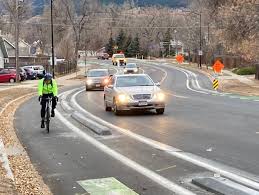Ten years ago, Community Cycles faced a crushing defeat when Boulder’s city council voted to remove most of Folsom Street’s protected bike lanes south of Pine Street. Despite a summer-long campaign that included daily street ambassadors, community testimony at three council meetings, and even “love letters to Folsom” celebrating safer streets, we lost. The night before the final vote, we wore black to the council meeting in mourning for what was about to be taken away.
The defeat was the result of several factors: inadequate business community outreach, relentless coverage from the Camera’s editors who gave front-page exposure to critics, and the toxic politics of an election year when incumbents wanted to eliminate any controversial issues. What followed were years of damaged relationships with the Transportation Department, making it nearly impossible to advance any new bike infrastructure.
Boulder Shifts Gears
Boulder has transformed dramatically in the past decade. A new city council embraces protected bike lanes and created the Core Arterial Network (CAN), an ambitious plan to connect every neighborhood with safe cycling routes that make car-free or car-lite living genuinely viable. The contrast couldn’t be more stark. A new Folsom design, developed with extensive business and community support, recently passed council on the consent agenda without debate.
The current Transportation Department is delivering exceptional street designs across the CAN network. Projects on 30th Street, Baseline, Iris, and Folsom incorporate innovative solutions that balance competing safety needs while respecting each corridor’s unique character. The Folsom design particularly stands out as a vision for a beautiful, livable street. This is especially compelling as 28th Street becomes increasingly highway-like under current construction.
In the Same Lane for a Better Boulder
Perhaps most importantly, Community Cycles’ relationship with the Transportation Department has emerged stronger than ever. While significant city staff turnover occurred, the current team of planners, engineers, and outreach specialists represents an outstanding partnership. Combined with leadership changes in the City Manager’s office and a supportive city council, Boulder is finally on track to become a truly walkable, bikeable city.
Ten years later we can hardly believe it took this long – yet somehow we’re not surprised. A safer, more livable, beautifully designed Folsom is finally within reach, along with numerous other streets that will make cycling safe and accessible for everyone.
Read more about the demise of the first Folsom project: What role did city politics play, Council votes to remove protected lanes, Bicyclists protest.



